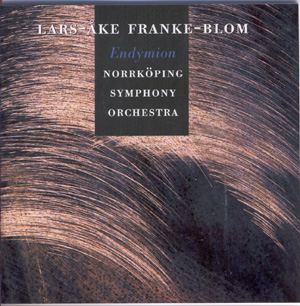Lars-Åke Franke-Blom was born in Norrköping
and is primarily self-taught. The qualifier indicates that he has had
some studies with Nils Eriksson and also with a much more famous name,
Daniel Börtz. There have been a spread of performances in Scandinavia
- mostly in Sweden. His first concert performance came in 1975 with
his suite for flutes and percussion. Since then there have been concertos
for cello, viola and double bass as well as a handful of symphonies.
Endymion is the most recent piece on
the disc. It is uncompromisingly tough, with irruptions of dissonance,
rattle and pandemonium threaded through which comes lissom melodic material
of heart-easing or soul-searing Scandinavian character. This is usually
carried on the violins. Strange bumping rhythms and exhausted woodwind
calls are clearly influenced by Allan Pettersson’s symphonies which,
given his location in Norrköping, Franke-Blom must surely have
heard in concert during the 1970s. The occasional discreet cough betrays
a live concert recording. This is a very different Endymion from
the Converse tone poem I have been hearing recently on Naxos.
One single movement piece is followed by another. Längtäns
väv or ‘Web of Yearning’ is designated by the composer
‘a tone poem’ (somehow a rather incongruous label for such ‘modernity’).
The brass groan, the orchestra ripples slowly with sour whispers and
protests, raucous and undisciplined. Delicacy in this case certainly
does not preclude thorny invention. There are quiet ice-scenes which,
in their enclosed self-absorption, reminded me of Benjamin Frankel’s
Second and Fourth Symphonies. This music narrates a trajectory from
description of the river from which the industrial world’s energy can
be drawn, to factory activity, looms and machinery (here percussion
as well as jeering brass come into their own). The looms are heard sliding
to stop (very illustrative music at 15.30). A string hymn rises from
the dissonant ‘bed’, gathering momentum and a comparatively conventional
but still moving sweetness. This is part Beethovenian anthem, part Sibelian
hymn. Such moments as this remind me of the ‘people’s paean’ that emerges
from Panufnik’s Heroic Overture. This music was written with
photographs of Norrköping’s industrial zone in mind, a landscape
that has changed utterly as a university, museums and concert hall have
risen in the place of stacks and machinery. There is a resolute Alan
Bush tone to the composer’s outline: ‘Calm waters; Dark masses of water
in motion; Waterfall and empty industrial buildings; The machines are
started. Weaving and looming; The machines are turned off; Song dedicated
to the workers; Demonstration and fight for a better world.’
The Symphony No. 3 is in three sections and
reflects the composer’s interaction with visual art; this time the paintings
of Anselm Kiefer. The first episode is Jakobs Traum. This picks
up bark, rattle and protest and shows acquaintance with Ligeti’s opera
Le Grand Macabre relieved surprisingly almost disconcertingly
by a dreamily extruded segment of writing for solo string instruments.
Elisabeth von Österreich dreams quietly. Then comes Voyage
au bout de la nuit is alive with hysterical protest, abyssal chaos,
brass expostulation, intimations of terror of the sort found in Havergal
Brian’s Gothic Symphony and, to end, a Varèse reference:
the brief howling of a siren.
This release is thoroughly well documented and will
have pleased the composer. My only regret is that the visual stimulus
for this music was not reproduced beyond a single photograph in the
booklet. Perhaps later discs will proffer his Symphony No. 2 premiered
in 1995 by Jin Wang and the Cello Concerto. The work is subtitled Lustarnas
trädgård (The Garden of Earthly Delights or Lusts
as the booklet has it). Yes it is inspired by the painting by Hieronymus
Bosch.
Tough going for the most part. Here is a composer who
seems to have found his milieu in the avant-garde language of the 1970s.
Endymion may well be evidence of a movement towards lyricism
even if it is tortured and hard won.
Rob Barnett
